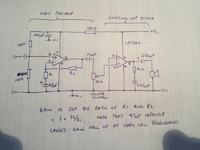charles80
Newbie level 5
Hello,
I'm currently testing this circuit (not my design) to detect small light changes/vibrations using light.

I'd like to know which IC I could use to replace the LM386 I'm currently using (don't know if it's LM386-N3 or an older one).
Here on this website the author measured his LM386 THD at 7%, while using a goldstar-made GL386 THD was just 0.6%, though it proved impossible for me to source these goldstar ICs.
Reading various opinions on the net, some people would say that NE5532 would be a good pre-amplifier but then I'd have to implement the circuit to use both NE5532 and LM386, which is beyond my current knowledge. Others would swear by the TDA7052A.
Since I already tried to minimize circuit noise by using low tolerance resistors (1%) and polypropylene/polystyrene capacitors whenever possible, my last noise source would be the LM386 which AFAIK is set to its highest gain by placing that 10uF capacitor between pin 1 and 8.
I know that noise (and also gain) could be lessened by removing that capacitor, but since that IC is noisy by itself or at least was never known to be low noise, I'd like to know if there is anything better I'd either replace it with directly (thus using an 8 DIP IC and then wiring pins properly) to try obtaining the best of both worlds or implement the circuit with something else like 2 ICs, though I'd need more help since I don't have the technical knowledge to do so myself.
Of course any suggestion/improvement is welcome.
Thank you very much
I'm currently testing this circuit (not my design) to detect small light changes/vibrations using light.

I'd like to know which IC I could use to replace the LM386 I'm currently using (don't know if it's LM386-N3 or an older one).
Here on this website the author measured his LM386 THD at 7%, while using a goldstar-made GL386 THD was just 0.6%, though it proved impossible for me to source these goldstar ICs.
Reading various opinions on the net, some people would say that NE5532 would be a good pre-amplifier but then I'd have to implement the circuit to use both NE5532 and LM386, which is beyond my current knowledge. Others would swear by the TDA7052A.
Since I already tried to minimize circuit noise by using low tolerance resistors (1%) and polypropylene/polystyrene capacitors whenever possible, my last noise source would be the LM386 which AFAIK is set to its highest gain by placing that 10uF capacitor between pin 1 and 8.
I know that noise (and also gain) could be lessened by removing that capacitor, but since that IC is noisy by itself or at least was never known to be low noise, I'd like to know if there is anything better I'd either replace it with directly (thus using an 8 DIP IC and then wiring pins properly) to try obtaining the best of both worlds or implement the circuit with something else like 2 ICs, though I'd need more help since I don't have the technical knowledge to do so myself.
Of course any suggestion/improvement is welcome.
Thank you very much
